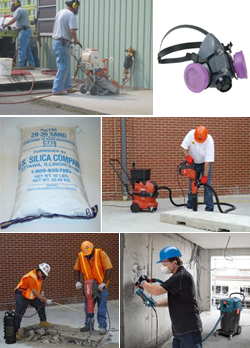 Respirable Crystalline Silica
Respirable Crystalline Silica
It is the responsibility of the University of Maryland to take precautions to eliminate potential hazards in the workplace. The purpose of the Respirable Crystalline Silica Program is to provide the hazards associated with silica dust and outline the steps to take to ensure employees who work with, or around silica are not exposed to hazardous levels of silica dust and to provide procedures for common silica related work duties to minimize exposure in accordance with the OSHA standards 29 CFR 1910.1053 and 29 CFR 1926.1153.
Crystalline silica is a basic component of soil, sand, granite and many other minerals. Quartz is the most common form of crystalline silica. All materials containing silica can result in the presence of respirable silica particles when chipping, cutting, drilling or grinding takes place.
Silica exposure occurs through inhalation of silica containing particles and occurs through many construction and general industry methods. The most severe exposures generally occur during abrasive blasting with sand to remove paint and rust from bridges, tanks, concrete structures and other surfaces. Other activities that may result in sever silica exposure include jack hammering, rock/well drilling, concrete mixing, concrete drilling, brick and concrete cutting/sawing, tuck pointing and tunneling operations. Exposure to excessive silica dust over long periods of time can result in silicosis.
Respirable Crystalline Silica Program
Coming Soon
Specified Exposure Control Methods when working with materials containing crystalline silica
UMD Exposure Control Plan
Coming Soon
